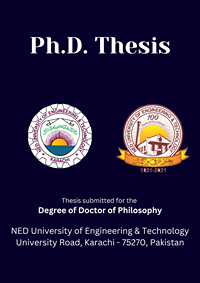Practical Quantum Key Distribution Based on Higher Dimension Protocol (PhD Thesis)
Material type: TextLanguage: English Publication details: Karachi : NED University of Engineering and Technology Department of Computer Science and Information Technology, 2022Description: xx, 144 p. : illSubject(s): DDC classification:
TextLanguage: English Publication details: Karachi : NED University of Engineering and Technology Department of Computer Science and Information Technology, 2022Description: xx, 144 p. : illSubject(s): DDC classification: - 621.3820378242 KAM
| Item type | Current library | Shelving location | Call number | Status | Date due | Barcode |
|---|---|---|---|---|---|---|
 Reference Collection
Reference Collection
|
Reference Section | Reference Section | 621.3820378242 KAM | Available | 98676 | |
 Reference Collection
Reference Collection
|
Reference Section | Reference Section | 621.3820378242 KAM | Available | 98677 |
Abstract :
Numerous intriguing and new ideas have been offered for quantum key distribution (QKD) since its inception in 1984 in terms of security and system efficiency while also taking into consideration its benefits and practical implementation. Normally, to achieve extremely long distances in secret key sharing using QKD without any intruder interruption, schemes with high error rates are incorporated. One such scheme is the so-called KMB09 protocol, which was developed to make use of higher dimensional photon states, which are not feasible with the standard BB84 scheme.
The KMB09 based practical QKD system with quick eavesdropping error rates has not yet been reported. In our research, we provide a methodology for the development of a QKD system that runs in two or more dimensional schemes of photon states. We propose the development of a KMB09 based high dimensional (HD) QKD system, which is built on the encoding of secret data in higher-order Gaussian beam spatial modes. The suggested framework is examined primarily in terms of efficiency while dealing with photon states in two and four-dimensional scenarios. We discover that the simulation results obtained using the suggested framework are consistent with the numerical and analytical findings obtained using the existing QKD models.
The introduction of an inevitable error rate into a QKD link caused by the presence of malicious interception by a man-in-the-middle instantly informs both the sender and the receiver. Higher-dimensional QKD protocols, such as KMB09, have higher eavesdropping error rates and better intrusion detection, but their practical implementation is indeed a long way off. We present a comprehensive error-rate study of the KMB09 protocol implementation, which includes two distinct kinds of eavesdropping error rates. Moreover, we illustrate the decoy-state approach to demonstrate the protocol's resistance to a photon-number-splitting ( one of the types of attacks), which we believe is an important contribution.
When using high-dimensional encapsulation of quantum bits in quantum key distribution, a quantum signal's confidentiality and knowledge carrying capabilities are both enhanced. It has been found that the effectiveness of such communication is significantly reduced as a result of the distortion of orbital angular momentum (OAM) states caused by atmospheric turbulence. For this purpose, we specifically investigate the influence of atmospheric turbulence on the error rates of QKD, which is believed to be the global standard in assessing the security of such communication via the quantum channel with the existence of an outsider (man-in-the-middle). Our findings indicate that under normal circumstances, turbulence has no substantial impact on the successful propagation of hidden quantum bits across sender and receiver. As a consequence of medium-level turbulence, we discover an intriguing shift in the profile of error rates that may be used to indicate the existence of an attacker with high precision.
